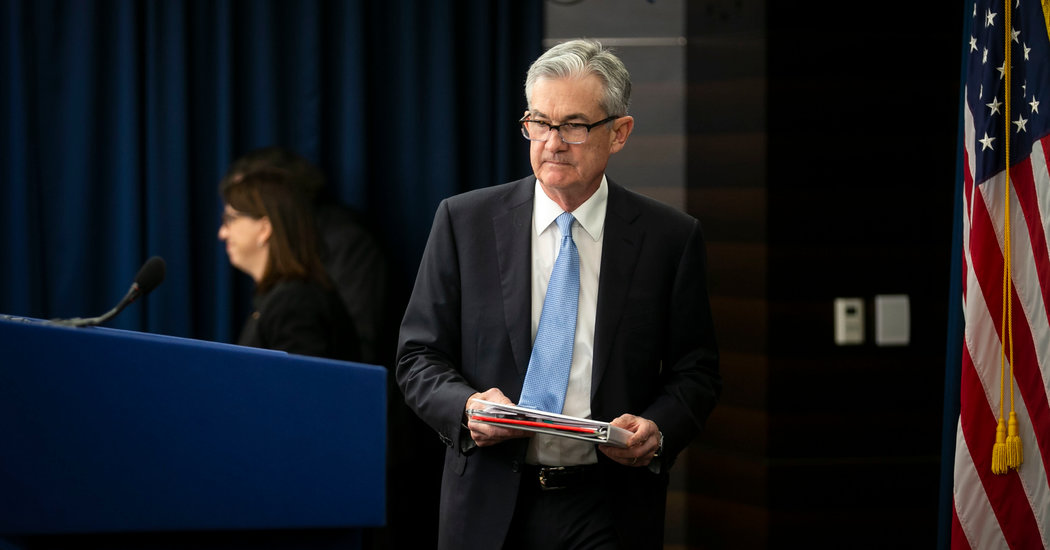WASHINGTON — Federal Reserve officials are poised to disappoint President Trump at the conclusion of their two-day policy meeting on Wednesday, with the central bank expected to leave interest rates unchanged despite Mr. Trump’s repeated calls for it to start cutting rates.
Mr. Trump has criticized the Fed’s 2018 interest rate increases for slowing growth and called on it to start using its tools to stimulate the economy. On Tuesday, Mr. Trump said in a tweet that the Fed should lower its benchmark rate by a percentage point, saying such a move could send United States economic growth “up like a rocket.”
He compared the Fed’s approach with that of China, a partly managed economy, saying: “China is adding great stimulus to its economy while at the same time keeping interest rates low. Our Federal Reserve has incessantly lifted interest rates, even though inflation is very low.”
But the policy-setting Federal Open Market Committee, which operates independent of the White House, is widely expected to hold rates steady on Wednesday when it releases its decision at 2 p.m. Fed officials are unlikely to explicitly suggest that a rate reduction is coming anytime soon, economists think.
Mr. Trump is not the only one looking for a rate cut. Wall Street investors increasingly expect the Fed to reverse some of last year’s rate increases as inflation softens. But the Fed must balance weak price increases with otherwise solid progress: Consumer spending and job market figures have been coming in strong, and the Fed has already shifted away from monetary tightening and toward patience this year. Officials will most likely wait to see how the economic data plays out before adjusting course.
“They’re in a good place,” Michael Feroli, the chief United States economist at J.P. Morgan, said of the Fed. “Growth is above trend, financial conditions are easy, so that should continue to support above-trend growth, and they believe that should support firming inflation pressures over time.”
Many of the risks that prodded the Fed toward patience have since faded. Shaky markets have rallied, financial conditions have eased, spending has rebounded and growth was better than expected in the first quarter.
Yet annual price increases slowed to 1.6 percent on a core basis in March, taking the Fed further away from its stubbornly elusive goal of 2 percent inflation. Weak inflation raises the risk of economy-damaging deflation, so the central bank aims to keep prices growing at a slow and steady rate.
That disconnect poses a serious policy challenge. If officials cut rates to lift prices against a backdrop of strong growth, they risk fueling financial excess and looking like they have caved to political pressures.
Should inflation slip too low for too long, on the other hand, businesses and consumers could come to expect permanently slower gains and behave accordingly. That would make it harder for the Fed to ever achieve its 2 percent goal.
Charles L. Evans, the president of the Federal Reserve Bank of Chicago, has indicated that rate cuts are possible if inflation falls too low and stays there. “Anything that’s sustainable, that looks like it’s moving downward, not upward, I would be extremely nervous about,” Mr. Evans told The Wall Street Journal in April. “I would definitely be thinking about taking out insurance in that regard.”
The full committee will not release fresh economic projections until after its June meeting, but Jerome H. Powell, the Fed chairman, could flesh out what conditions would merit a precautionary cut and explain whether such a move is becoming more likely during his postmeeting news conference.
Subtle statement tweaks could also provide the setup for a future shift. Officials could use their release to highlight lower inflation as a real risk rather than a transitory miss, said Neil Dutta, the head of economic research at Renaissance Macro Research.
“If they sound more dovish on inflation, more worried about where inflation is going, that would tee up the idea that there could be a policy response,” Mr. Dutta said.
The Fed cut rates three times total in 1995 and 1996 because inflation was slowing, so tweaking policy around the edges against a strong economic backdrop with relatively low recession risks would not be unprecedented.
“It’s one thing if the Fed is cutting because the economy is getting worse,” Mr. Dutta said. “It’s another thing if they’re just trying to reinforce their inflation target in an otherwise healthy economy.”
Still, Mr. Dutta thinks it is more likely that the Fed’s next rate move is up. Goldman Sachs economists also expect an increase, though not until late 2020.
“Fed officials would likely worry about the risks that a rate cut could appear political or unnerve markets,” Goldman’s chief economist, Jan Hatzius, and his colleagues wrote Thursday in a note. They “might mistake a cut in response to low inflation for serious concern about the growth outlook.”

